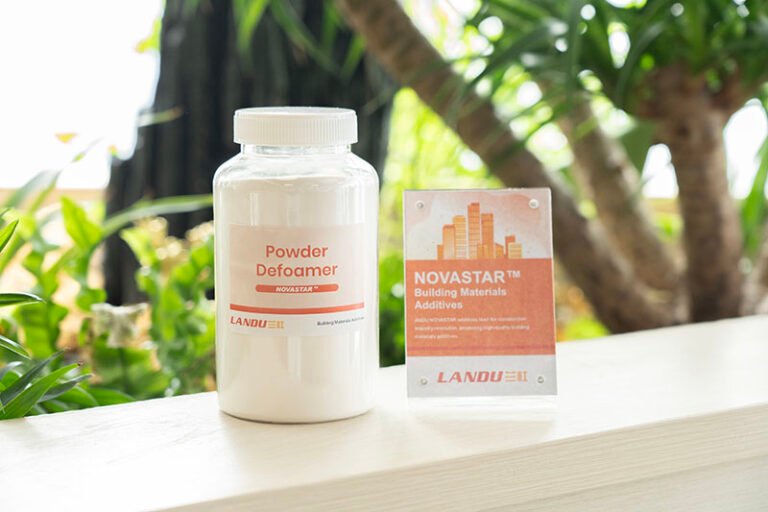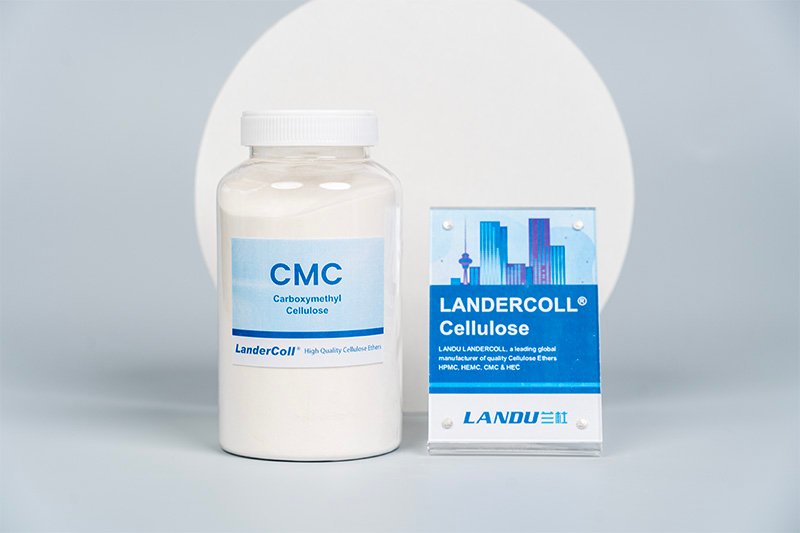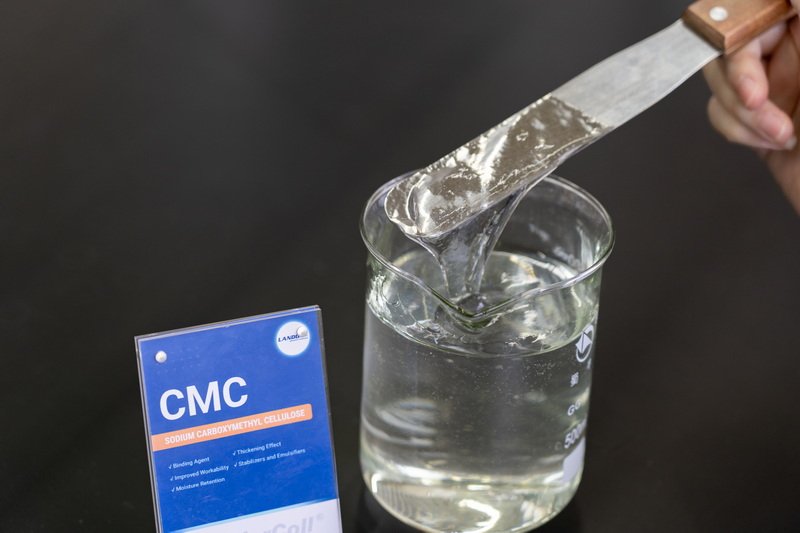Carboxymethyl cellulose (CMC) emerges as a hydrosoluble, charged cellulose derivative esteemed for its outstanding moisture preservation, potent densification, and unifying layer creation. Within cement- and plaster-rooted frameworks, an apt CMC variant steadies wet combinations, augments usability, fosters reliable curing, and uplifts conclusion excellence. At LANDU, our building-focused CMC array is designed for basic settings and elevated-ion scenarios, offering foreseeable density accumulation, managed hardening outlines, and harmony with contemporary enhancer sets.
This extensive overview converts CMC’s molecular traits into actionable blending advice for the four usage groups noted:
- Binders
- Coatings
- Slab attachments
- Thin layers
You’ll discover practical specifics on CMC’s operations in mineral frameworks; how attachment extent (DS), chain length (blend density), and ion endurance mold outcomes; how to pick variants and measures; and how to integrate CMC with flow boosters, re-dispersible polymeric dusts (RDP), starch derivatives, bubble suppressants, and hardening adjusters. We also cover preparation and validation routines, environmental adaptations, problem-solving, illustrative scenarios, and a streamlined rollout blueprint. The aim is trustworthy, reproducible site outcomes with scarcer flaws, reduced redo, and superior placer involvement.
1) Defining CMC and Its Significance
CMC originates from attaching carboxymethyl units to the cellulose chain, typically as sodium salt. This alteration bestows liquid dissolvability and a charged nature, unlocking four primary roles in construction substances:
Moisture preservation: CMC captures available liquid and curbs vapor loss while tempering pull into absorbent bases. This narrows wetness disparities through the layer, lessening initial contraction and early fine fractures, and bolstering thorougher cement curing or plaster crystal development.
Densification and flow oversight: As a pliable, long-chain charged polymer, CMC heightens blend density and confers force-responsive thinning. Combinations move easily under force (spreading, propelling, brushing) and reform framework idle, aiding in settling reduction and boundary clarity preservation.
Unity and attachment: By crafting seamless molecular layers and linking between granules and base irregularities, CMC adds moist grip and early initial unity. In slender applications, this unity facilitates neat leveling and cuts ripping.
Usability and sensation: Slick coatings on granule exteriors diminish spreading force and boost slide. Placers sense a “velvety,” manageable paste that distributes evenly and concludes neatly.
Two features set CMC apart from neutral cellulose derivatives:
- Charged density: Electrical repulsion among polymer parts enhances chain spread (greater effective size), boosting densification potency but also rendering density vulnerable to ion levels.
- Bonds with multi-charged ions: CMC can pair with Ca2+/Mg2+. In cement fluid spaces, this might sway curing speeds and occasionally hasten density drop if the variant lacks ion endurance.
Why is CMC indispensable in a sector navigating sustainability, efficiency, and resilience? Envision laying a mortar on a porous base in scorching heat—without CMC, rapid drying could cause cracks, weakening structures and wasting resources; with it, the material holds moisture, ensuring durability and reducing environmental footprint through lower repairs.
2) CMC’s Behavior in Cement and Plaster Setups
2.1 Principles in Cement-Based Substances
Hydration regulation: Cement uses liquid as curing advances; simultaneously, liquid is drawn into absorbent bases and lost to vapor. CMC slows exterior liquid loss and tempers base pull, retaining sufficient liquid for curing and boundary link creation. Outcomes include scarcer initial fractures and firmer early attachment.
Flow dynamics and framework rebound: CMC blends exhibit simulated plastic traits. Under force, density falls for simple distribution and propelling; post-force, framework reforms to oppose droop. In spread binders and slab attachments, this sustains grooved patterns and lessens upright slip. For instance, in a high-rise facade, CMC’s rebound acts like a safety net, preventing the mix from cascading down.
Exterior activity and gas: CMC’s exterior traits can introduce gas, lowering wet compactness. Minor stable tiny gas can aid usability, but abundance weakens robustness and attachment. Suppressant choice and agitation energy are pivotal oversights.
Curing speeds and hardening outline: Charged polymers can cling to cement granules and bind Ca2+, often delaying early curing of key phases. Practically, CMC might extend hardening duration—beneficial in warm/arid settings but problematic if over-measured or in cool, damp weather. Variant selection (DS, chain length, ion endurance) and measure dictate the overall impact; boosters (e.g., calcium salt) can re-equilibrate hardening as required. This interplay is crucial in blends with alternative cements like those with fly ash, where CMC can mitigate uneven hydration.
2.2 Principles in Plaster Coatings and Thin Layers
Crystal aid: Plaster hardens by forming interlocking crystals. CMC’s moisture hold guarantees even starting and expansion, minimizing voids and “dry” flaws on pull bases.
Glossy conclusion and abradability: Steady flow and regulated liquid loss produce denser, glossier layers with fewer spread marks. When abrading is needed, avoid over-toughening the exterior (CMC avoids glassy; it usually aids balanced abrading when measured correctly).
2.3 Anticipated Vulnerabilities
- Ions and basics: High ion levels in cement fluid spaces can compress the polymer (charge block), cutting apparent density. LANDU building variants are chosen for superior ion/basic endurance; still, lab evaluation in your adhesive and enhancer set is vital.
- Heat: Unlike other derivatives, CMC lacks heat solidification in usual building ranges. Raised heats modestly cut blend density (typical for polymers). CMC maintains consistent sensation across seasons but may exhibit greater hardening delay in chill if measure is high.
3) Variant Choice: Key Aspects and Their Importance
3.1 Attachment Extent (DS)
- DS outlines the average carboxymethyl units per sugar unit (usual building variants ~0.7–1.2). Greater DS boosts liquid dissolvability and densification potency but can heighten ion vulnerability.
- Actionable guideline: For cement-heavy, high-basic setups, pick DS balancing dissolvability with ion endurance (LANDU suggests DS spans per usage).
3.2 Chain Length (Blend Density)
- Assessed as density of a set CMC blend (e.g., 1–2% at 25°C). Greater density variants offer potent moisture hold and framework at lower measures but might amp gas and blending force.
- Usual picks:
- Subtle density: Propellable binders, base layers with high flow boosters, or cases needing minimal hardening effect.
- Moderate density: General binders, coatings, thin layers.
- Intense density: Thin applications needing strong boundary grip or upright droop aversion; use cautiously to shun over-gas and slow hardening.
3.3 Ion and Basic Endurance
- Cement fluid spaces hold high ion equivalents; slab attachments and fixes may be more challenging. LANDU provides CMC variants refined for such settings to lessen density collapse and sustain moisture hold.
3.4 Cleanliness and Residue
- Lesser residue cuts blooming risks. Strict oversight of sodium and leftover salts bolsters foreseeable outcomes and tidy exteriors.
3.5 Granule Size and Swelling Outline
- Finer dusts scatter swiftly but can clump (“lumps”) if loaded poorly. Coated variants delay swelling to permit full saturation under vigorous charging.
3.6 Choosing via LANDU
- We match DS, density span, and ion endurance for each usage. A standard evaluation matrix covers two density spans and two DS ranges at three measures—under warm/arid and cool/damp—to chart outcome bands pre-expansion.
4) Usage-Specific Refinement
4.1 Binders (Stonework, Fix, Base Layers)
Aims
- Foreseeable usability and mix lifespan
- Lessened seepage/division and even conclusion
- Regulated hardening outline across seasons
- Balanced gas levels for sensation sans robustness loss
CMC’s Function
- Moisture hold keeps binders usable on absorbent stonework, boosting link and cutting weak seams.
- Simulated plastic flow steadies wet state, oversees settling on uprights, and uplifts conclusion.
- Unity lessens granule drop and boosts overhead usability.
Supporting Elements
- Flow boosters lower liquid needs; uphold minimal CMC measure to keep unity/moisture hold as ratio drops.
- Suppressants: Vital to manage gas (pick oil or silicone types matching CMC and basic setups).
- Boosters (e.g., calcium salt) mitigate hardening delay where cool or high CMC slow strength gain.
Standard Initial Measure (by Dry Blend Mass)
- 0.05–0.25% based on adhesive content, environment, and sought mix lifespan.
Method/Validation Remarks
- Flow/settling (surface or taper), wet compactness/gas levels, start/end hardening (probe), and conclusion span. Adjust CMC in defined range rather than single points.
Typical Problems and Fixes
- Slow hardening/low early robustness: Cut CMC measure; switch to lower DS or density type; add booster; elevate drying heat if feasible.
- Excess gas/low compactness: Add suppressant sooner; cut agitation energy post-density accumulation; down density type.
4.2 Coatings (Cement/Lime/Plaster Exteriors and Concluding Layers)
Aims
- Effortless spreading with lowered bounce
- Droop aversion on uprights and boundary stability
- Even dehydration, minimal voids
- Specified abradability (for concluding layers)
CMC’s Function
- Moisture equalization through the layer and usable on absorbent bases.
- Recoverability enables high accumulation sans collapses; unity bolsters sharp edges at grooves and corners.
- For plaster, CMC aids even crystal growth and lessens dusting.
Supporting Elements
- Lime boosts sensation and conclusion; with CMC, lime can sometimes be cut sans flow loss.
- Fine threads aid fracture oversight; CMC holds threads evenly.
- Repellents add liquid opposition; check match and usability impact.
Standard Initial Measure (by Dry Blend Mass)
- Cement/lime exteriors: 0.05–0.20%
- Plaster coatings: 0.05–0.15% (adjust for hardening; CMC can prolong)
Method/Validation Remarks
- Taper flow, droop assay on upright panel, early exterior look, and 1-2 day fracture chart. Tune measure and density type to hit droop aversion and conclusion without over-delay.
Typical Problems and Fixes
- Fine fracturing in warm/arid: Slightly amp CMC; use denser type; shade and/or amp moisture during early drying.
- Pull/ripping: Check suppressant timing; ensure sufficient swelling pause pre-final blending; ponder minor merge with neutral derivative for velvety sensation.
4.3 Slab Attachments (Thin-Layer, Medium-Layer, Oversized)
Context and Aims
- Steady pattern outline, prolonged usability, non-slip on uprights, robust attachment post-testing (warmth, liquid, cold cycles), and tidy ridging/shift.
CMC’s Function and Notes
- CMC offers moisture hold and unifying framework sustaining pattern stability and usability. Yet, versus other derivatives, CMC’s charged nature can amp gas and delay curing more strongly at like measures, and density may be more vulnerable to fluid ions.
- In contemporary setups, CMC is frequently in refined merges (with neutral derivative and RDP) or in specific environments/bases where its potent moisture hold shines.
Collaboration with RDP and Starch Derivative
- RDP uplifts attachment (fresh and tested) and adaptability. CMC’s moisture hold aids RDP re-spread and merge.
- Starch derivative sharpens recoverability for slip aversion sans large CMC ups.
Standard Initial Measure (by Dry Blend Mass)
- 0.05–0.20% CMC in merges; for CMC-heavy designs, 0.10–0.30% with cautious gas/hardening oversight. RDP usually 2–5% based on efficacy class.
Method/Validation Remarks
- Slip (upright slab assay), usability (grip shift), pattern failure/shift, pull attachment (fresh and post-testing), wet compactness/gas.
Typical Problems and Fixes
- Upright slippage: Amp recoverability via minor starch add; modestly up CMC type; manage gas with suppressant to keep compactness in norm.
- Brief shift on low-pull porcelain: Amp RDP or adjust wetters; check pattern integrity and tool angle.
4.4 Thin Layers and Surface Fillers (Cement- or Plaster-Based)
Aims
- Tapered stability, glossy conclusion, low voids
- Even drying sans boundary curl
- Attachment to cement bases and readied panels
- Specified abradability where relevant
CMC’s Function
- Potent moisture hold fosters even layer creation and lessens exterior voids.
- Simulated plastic flow keeps tapered flat and averts settling.
- In plaster thins, CMC tempers hardening and boosts slide; measure conservatively to shun over-delay.
Supporting Elements
- Subtle calcium mineral for glossy conclusion; RDP (1–3%) to up attachment and unifying robustness on dense or prior-coated exteriors; repellents where low liquid uptake needed.
Standard Initial Measure (by Dry Blend Mass)
- Cement-based: 0.05–0.25%
- Plaster-based: 0.05–0.15%
Method/Validation Remarks
- Blade pull, tapered grip, void count, exterior gloss/evenness, abradability grade. Adjust CMC measure/type and suppressant to hit conclusion goals sans over-softening the layer.
Typical Problems and Fixes
- Boundary curling: Slightly amp CMC; slow early drying (tweak air/moisture); confirm base dust-free and not over-warm from sun or air.
- Void flaws: Add/re-tune suppressant sooner; cut vigorous mixing post-density; check base heat.
5) Harmony and Collaboration: Constructing the Package
- Flow boosters: Cut liquid needs and better movement. Balance with CMC to keep unity and moisture hold at lower ratios. Assay for density drift (ion effects).
- Re-dispersible polymeric dusts (RDP): Merging CMC with RDP betters attachment and fracture opposition; CMC enables solid re-spread and layer creation by sustaining moisture and steadying wet paste.
- Starch derivatives: Offer targeted recoverability and quick framework rebound, especially helpful in attachments and upright coatings. Using starch may permit lower CMC measures while keeping droop aversion.
- Suppressants: Pick proven in basic, derivative setups. Add promptly and shun excess post-accumulation agitation. Validate suppressant avoids negative attachment impact (particularly on dense bases).
- Hardening adjusters: Salts or aluminate can counteract CMC-induced delay in cool or high-measure cases. Confirm no adverse bonds with RDP or gas-introduction.
6) Preparation, Swelling, and Quality Oversight
6.1 Scattering and Swelling
- Premix CMC with part subtle bulk to isolate granules and avert clumping.
- Add powders to liquid under agitation (never opposite). For coated types, permit brief saturation pre-vigorous to ensure full wetting pre-density rise.
- Pause and re-mix: Post-initial, pause 2–10 minutes for swelling then re-mix to final.
6.2 Gas and Bubble Oversight
- Minimize unneeded vigorous once goal density achieved. Assess suppressant type/measure and add promptly. Track wet compactness and gas; set control bounds by item.
6.3 Validation for Received CMC
- Dampness level and bulk compactness (measuring/handling uniformity)
- Blend density at norm concentration/heat (lot uniformity)
- DS (reported or inferred)
- Residue (sodium) and cleanliness (blooming risk, preservation reliability)
- Granule size and swelling outline (scattering/clumping behavior)
6.4 Validation for Wet Mixes
- Flow/distribution or taper settling; wet compactness/gas levels
- Hardening time (probe/needle)
- Droop/slip assays for upright uses
- Usability and attachment (attachments)
- Exterior look (voids/ripping) for thins/coatings
7) Environment and Base Adaptations
- Warm, arid: Slightly amp CMC (or up density type) to prolong usability and cut initial contraction; shade and barriers aid. Pre-moisten high-pull bases if permitted.
- Cool, damp: Shun over-delay; ponder down measure or density type. Use boosters judiciously to restore hardening and early robustness.
- High-pull bases: Seal or lightly pre-moisten; up CMC to sustain moisture in the layer.
- Dense, low-pull bases: Ensure solid wetting (additive/RDP aid) and control gas; excess gas cuts real contact and attachment.
8) Problem-Solving and Remedies
Sign: Slow hardening or low early robustness
- Probable triggers: Over-measure; high DS/density type; cool settings; mismatch enhancers.
- Fixes: Cut CMC measure; select lower density or adjusted DS; add booster; elevate drying heat; check suppressant match (some amp delay).
Sign: Excess gas, low wet compactness, or weak attachment on dense bases
- Probable triggers: High agitation energy post-density; suppressant timing/type; high CMC density type.
- Fixes: Add suppressant sooner; cut post-accumulation agitation; down density type or measure; amp RDP to better contact.
Sign: Droop on uprights or pattern collapse in attachments
- Probable triggers: Inadequate recoverability or rebound; subtle density type; high heat sans heat gel aid (CMC lacks).
- Fixes: Slightly up CMC measure/type; add starch for sharper rebound; adjust aggregate spread and liquid need.
Sign: Void/porosity in thin layers or coatings
- Probable triggers: Gas introduction; exterior crusting from warm air; inadequate suppressant.
- Fixes: Re-tune suppressant (type/measure/timing); cut vigorous; manage air and moisture to avert early crusting.
Sign: Poor spreading slide or “pull”
- Probable triggers: Under-slicked structure; insufficient swelling duration; mismatch co-enhancers.
- Fixes: Permit pause/re-mix; check suppressant and wetter bundles; ponder minor merge with neutral derivative for velvety sensation.
9) Illustrative Scenarios
Scenario 1: Stonework binder in warm, gusty settings
- Issue: Quick moisture loss causing initial fractures and rough conclusions.
- Action: Upped LANDU CMC from 0.08% to 0.14% (moderate density, ion-tolerant type); introduced early suppressant add and shades.
- Result: Mix lifespan prolonged by ~10 minutes; initial fracturing gone; conclusion smoother with fewer passes.
Scenario 2: Plaster concluding coating with voids
- Issue: Frequent voids and uneven gloss.
- Action: Changed to LANDU CMC with slightly higher density and better ion endurance; added suppressant at grind; cut high-agitation time post-density.
- Result: Void count dropped sharply; exteriors denser and more uniform; abrading labor within norm.
Scenario 3: Slab attachment on low-pull porcelain
- Issue: Inadequate shift and occasional upright slippage.
- Action: Adopted CMC/other blend (CMC 0.12% + other 0.20%) with 3.5% RDP; added small starch fraction for sharper recoverability; tuned suppressant.
- Result: Pattern stability bettered; shift upped; slip cut below threshold; tested attachment rose across warmth and liquid cycles.
Scenario 4: Fix binder in cool, damp weather
- Issue: Slow hardening and delayed robustness gain.
- Action: Cut CMC from 0.18% to 0.10% and changed to lower-density type; added 0.4% booster; slightly upped drying heat.
- Result: Hardening back to goal span; early robustness recovered; exterior conclusion acceptable.
10) Eco-Friendliness and Economic Value
- Reduced redo and waste: Superior moisture oversight and exterior excellence mean fewer recalls and fixes, lowering built-in emissions and expense.
- Liquid and power efficiency: CMC cuts added liquid for goal sensation and lessens need for aggressive drying/heat to drive hardening, especially in coatings and thins.
- Lightening potential: Modest, controlled gas introduction can cut compactness while preserving usability, if robustness norms met.
- Harmony with low-emission cements: Screen CMC with eco blends; moisture hold often aids, while hardening may need nuance.
11) Rollout Blueprint: From Lab to Site
- Outline efficacy goals: Flow/distribution, wet compactness/gas, hardening span, usability, droop/slip, attachment/robustness, exterior indicators (voids, gloss, abradability).
- Pick candidate types: Two DS spans × two density bands. Assay at three measures under warm/arid and cool/damp.
- Secure scattering base: Refine booster measure and liquid content; avoid using CMC to hide poor spread or inadequate blending.
- Control gas early: Pick suppressant upfront and lock timing (often during initial liquid charging). Track wet compactness and gas as key parameters.
- Validate collaboration: Add RDP (if relevant), starch, repellents, and boosters one at a time; record bonds.
- Author procedure: Blending order, swelling pause, re-mix, site assays (flow, compactness, hardening, droop/slip, voids, attachment). Educate teams on liquid add discipline, tool angle/force, shade/air oversight.




